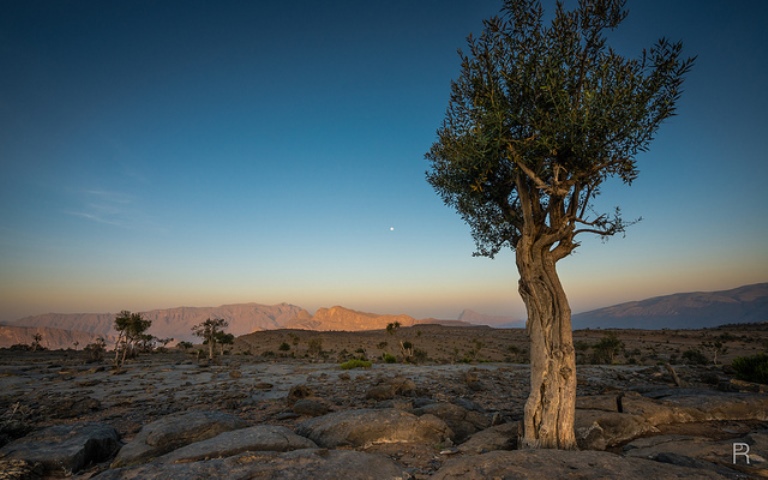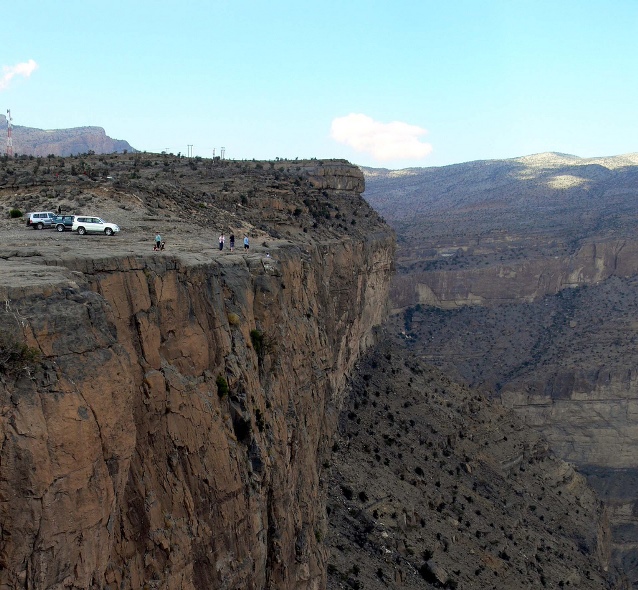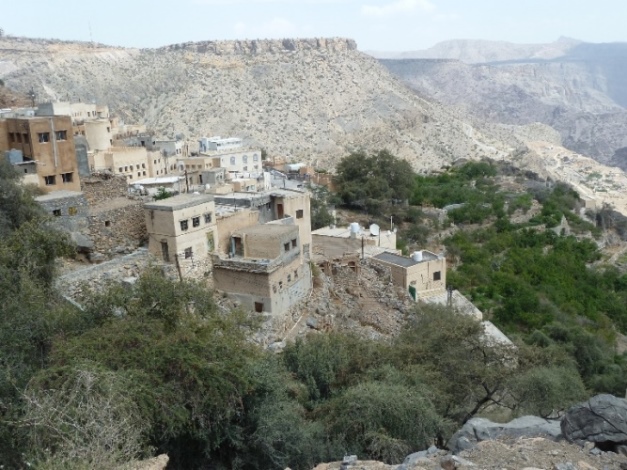Jebel Akhdar
Key information: Jebel Akhdar 
- This very varied region in the Western Hajar Mountains contains Oman’s (indeed the Arabian Peninsula’s) highest mountains and a superb array of landscapes.
- This is Oman’s premier walking/trekking area, from straightforward wanders between its villages, to tough traverses of its highlands, to thrilling tramping and clambering in its wadis (gorges).
Walkopedia rating
- Walkopedia rating93.5
- Beauty31
- Natural interest16
- Human interest14
- Charisma32.5
- Negative points0
- Total rating93.5
Vital Statistics
- Length: Your choice
- Maximum Altitude: 3,048m
- Level of Difficulty: Variable
WALK SUMMARY
This very varied region in the Western Hajar Mountains contains Oman’s (indeed the Arabian Peninsula’s) highest mountains and a superb array of landscapes, from the rough, tough broken limestone of its highlands, to the huge gorges crashing out of the range and the tremendous chasms falling off to the sides. To the north are the vast Wadi Bani Kharus, Wadi Bani Awf and Wadi Sahtan, which you can gaze on from the highest ridges and peaks at the range’s northern extreme. The range slopes southward, riven by gorges, in particular the grand Wadi Tanuf/al Qasha in its heart and Wadi al Muaydin to the east of the Sayq Plateau, a slightly strange area of rough undulating hills surrounded by gorges.
While there seems to be a bit of uncertainty about classification (some maps allocate it to the Jebel al Qannah), the range includes the Arabian Peninsula’s highest mountain, Jebel Shams (3,084m, although this appears to be uncertain, too) at its western end.
The range varies in its “feel”, from its arid lower slopes to its more vegetated highlands – although “greener” would be overstating it for much of the year: much is bare rock littered with shrubs and hardy plants making a tough living.
Oman is home to a huge range of plant and animal life, which is somehow counterintuitive considering how arid the country is, and is testament to its green credentials. That said, you will be lucky to see many mammals other than wild donkeys; and birds can be elusive even though Oman sits on major migratory routes and is a bit of birdwatching heaven.
The range shelters no less than 58 communities, although much of it feels very empty, and there are many deserted villages bearing testament to the fading traditional rural way of life – or the easier life now to be made elsewhere, if you like. The area was heavily fought over during the insurrection of the 1950s, and you will tread on detritus – mortar parts, rifle casings – as you walk the high ground, passing rough stone bastions and lookouts as you go.
This is Oman’s premier walking/trekking area, and contains a huge variety of walks, from straightforward wanders between its villages, to tough traverses of its highlands, to thrilling clambering in its wadis (gorges).
In the far west is the Jebel Shams area.
To the south of Jebel Shams itself is Wadi Nakhur, also known as Oman’s Grand Canyon, a huge and truly spectacular hole with vast cliffs dropping to its deep and, in its lower reaches, lush bottom. There are two waymarked, connected walks along its western rim to a maximum altitude of 1,900m. The Rim Walk follows old donkey trails linking Wadi Ghul at the canyon’s base to Al Khitaym on the high rim plateau, taking in a couple of abandoned villages en route. It has superb canyon views. The Balcony Walk from Al Khitaym on the high rim plateau to As Sab abandoned village is justly famous. This straightforward (if at times a tad vertiginous) but exciting and enormously atmospheric trail follows a wide, sloping ledge/fault in the vast cliffs of the canyon’s western side to a superbly sited abandoned village in a corner-bowl.
Peak baggers should try Oman's highest mountain, Jebel Shams. It is approachable from various directions, but the trail from the “plateau” to the west is the easiest and best known. It is still a long, demanding round trip, albeit a generally steady climb on generally reasonable paths. It barely needs saying that that the views from the summit are huge and stupendous.
Mid-Akhdar
Routes W8, W9 and W10, in the mid-range north-east of Al Hamra, lead in on old paths from: Balad Sayt in Wadi Bani Awf (see more below) to the north (W8); Sharaf Al Alamayn to the east (W10); and from the remarkable ancient village of Misfat al Abriyyin (well worth visiting in its own right, and you can stay here in old houses) to the west (W9), to meet on the high ridge (at around 2,000m) in the middle, so offer a number of different walking options to tailor to your wants, especially as they are varying nature and difficulties. You can either walk in and back if you need to get back to a car, or create a memorable day walk (of varying lengths) – and difficulties across the high, rough, magnificent mountains by joining the paths, which Wakopedia would love to do.
Qiyut to Ar Roos Traverse: Walkopedia did this walk, an inspiring meander along the high slopes, with huge views out over the chasms to both sides of the range. Marvellous. See our account of this walk [link to account in relevant page]. Part of the Long High Traverse, below.
Long High Traverse:This walk, from Ar Roos in the east along the high range to Jebel Shams, or vice versa, would be the ultimate Western Hajar walk. It follows Explorer route W10 in its middle part. It would take several days, and would probably require carrying full camping kit. (Diverting to find accommodation with resulting long days, or being met at key roadheads to be taken to accommodation, are in theory possible, but would involve at least one huge day.) Walkopedia is confident this would be an amazing walk, although we have not yet researched it. Detailed information in Adventure Trekking in Oman.
The East
The Sayq Plateau is a peculiar high areas of rough hills at the eastern end of the range. The best walk here is between the villages of its south-eastern rim: fascinating, historic villages in their terraces on the rim of dramatic Wadi Muaydin.
Wadi Muaydin: this endlessly deep gorge makes for fascinating exploration, as it slices its way southward from the edge of the Sayq Plateau in the eastern Jebel Akhdar. It is a beautiful place, and is easy walking with some minor scrambling. Most enter the gorge at its upper end and walk down to the roadhead where it widens out.
From Mutti north of Izki in the south-east, a good path with old stone steps leads up a steep wadi into the Jebel Akhdar.
The huge Ghubra Bowl in Upper Wadi Mistall, to the north-east, has superb scenery and walking below the Sayq Plateau. In particular, you can do the two very different walks between Hadesh and Wukan.
Wukan to Hadesh High Route: an Oman classic, a long, rough, in places steep and occasionally exposed loop from Wukan on the western wadi flank up the cliffs to the Wukan Pass onto the Sayq Plateau, where you curve round, on very different landscape, to the Hadash Pass at the plateau edge and thence back, steeply, to Hadesh on the eastern flank of the bowl.
Hadesh to Wukah: Lower route; an ancient trail links these villages, crossing the Ghubra Bowl. Fine views and the delight of the greenery around the villages: while it is marked, and less demanding than the higher route, it is hard work (and crosses several lower passes) and exposed in places, so not for beginners.
The super-fit could link these walks to make a long but exceptionally interesting circuit.
Northern Foothills
Wadi Hawasinah: another spectacular gorge, inland for Al Khaboura some 150km west of Muscat. This is a relatively demanding hike to a gorgeous pool for a well-deserved swim. It involves some “chain” assisted sections, so it isn’t for vertigo sufferers.
Wadi Bani Awf: This huge, multi-fingered gorge contains a number of interesting villages, including historic Balad Sayt on its little hillock among irrigated fields and date palms.A plethora of fine walks. Including on Explorer route W8 up to the high Jebel Akhdar ridge (see above) , and a short pop down the narrow, sheer sided canyon just below Balad Sayt.
Wadi Halfayn: a disused falaj channel runs some 6m up the wall of this dramatic gorge in the east of the Jebel Akhdar, leading to some deep pools for delightful swimming. Lush greenery. 2hrs to the first pool. The Persian Steps , 1,400 of them said to be cut by the…. er….Persians, lead to the high Jebel Akhdar. 4hrs one way.
Further info and photos needed- please send in!!
Wadi Abyadh:This lovely green gorge near Wadi Mistall contains a walk from the well-known blue calcite pools to the village of Al Abyadh. 1 ½ hrs one way.
Oman Trekking (Explorer) and Adventure Trekking in Oman (Anne Dale and Gerry Hadwin) have worthwhile sections on some of these walks. Recommended. Find relevant books on Amazon.
This page is at an early stage of development. Please help us by making suggestions and sending photos! Thank you!
For more information and photos, including detailed practical information and some warnings, see our Western Hajar Mountains walk page.
Other accounts: share your experiences
Your comments on this walk, your experiences and suggestions, and your photos are very welcome. Where appropriate, you will be credited for your contribution.
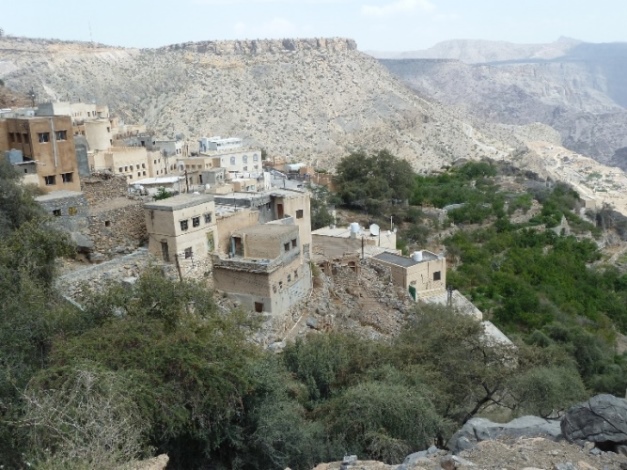
Safety and problems: All walks have inherent risks and potential problems, and many of the walks featured on this website involve significant risks, dangers and problems. Problems of any sort can arise on any walk. This website does not purport to identify any (or all) actual or potential risks, dangers and problems that may relate to any particular walk.
Any person who is considering undertaking this walk should do careful research and make their own assessment of the risks, dangers and possible problems involved. They should also go to “Important information” for further important information.
COMMUNITY COMMENTS AND PHOTOS
Name: Dick Everard
Posted on: 25/04/2017
I spent a week walking in Oman in 2007 including some of the walks listed. We stayed in the Jebel Akhdar Hotel and did most of the walks from there. I had two sources of information: Oman Trekking Paperback – 1 Jan 2006 by Explorer Publishing. This lists 12 hiking routes the longest of which is Wadfi Tiwi to Wadi Bani Khalid in Eastern Hajar. I note that this is currently priced at £112.36 second hand on Amazon or £2,876.96 new on Amazon. I still have a copy and am prepared to sell it!. I also had a copy of Adventure Trekking in Oman Dale, Anne; Hadwin, Jerry which cost me over £50 so I sold it when I came home for even more. This has many more walks with some quite long ones including the SAS walk which was the scene of an epic route march taken by the SAS in the 1971-76 war (a little too hard even for me). I note that neither Amazon or Abe have any copies available. This seems to be quite a common problem with foreign walking books, foreign bird or wild flower books. Great walking although very hot even in February.
Walkopedia says THANK YOU, DICK!
Name: Robert Polley
Posted on: 28/04/2017
Loved reading your description of the various treks in Oman's Jebel Akhdar: a region I used to know so well.
I did most of the routes you write about in the period 1987 - 1989; one of which I took two mules on to carry my soldiers' packed sarnies and water - in those days, there was a Mule Troop based at the top in the small military base; these muleteers were mostly drawn from the "adoo" or guys that opposed the Sultan's Forces during the 50s conflict stirred up by the infamous Imam of Nizwa. The problem on this particular trek became clear at the end of the trek in the valley at the very bottom of the Jebel Akhdar: we had to get the two mules onto the back of two Jaysh (military) lorries sent to transport us and the mules back up the Jebel. We learnt that mules are very stubborn indeed and, when they've decided not to get onto the back of a lorry, it takes a minimum of 10 "Jundees" (soldiers) to shove them up the ramp and onto the lorry! But there our problems did not end - far from it. These wheezing Bedford lorries had to stop three times on the track that climbed up the Jebel in order to have a little rest, as their engines just couldn't cope; hopeless, really. Subsequently, I climbed the SAS route up the Jebel amongst many others up the mountain, and explored all of the settlements and villages on top of the Jebel and on its flanks. My Omani Jaysh companions described me as being "waagid Jebali" or "like a mountain goat" as they struggled to keep up with me haha.Happy Days.
BTW: In my time there, our 1:25,000 maps had many inaccuracies: I recall one of the mountains in this Jebel Akhdar range being inscribed as "Jebel Ma'Aarif" which means "I don't know mountain". Why? Cos the Brits who did the surveying used to ask the locals "What's that mountain called?" and received their answer: "Walahee, ya seedee/akhee, ma aarif". Of course the hapless Brits spoke virtually zero Arabic......
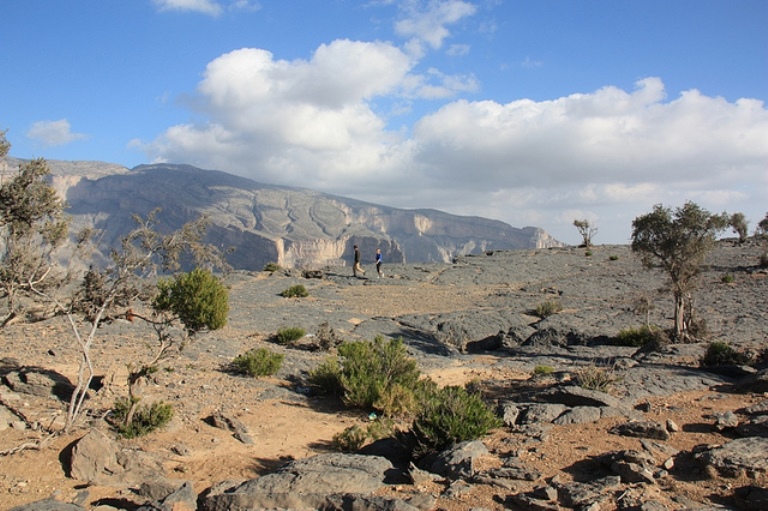
Anyone planning an expedition to this place should see further important information about this walk.
Responsible travel matters, a lot. How you travel will make a real difference - for better or worse. PLEASE consider this when making plans. Read more


